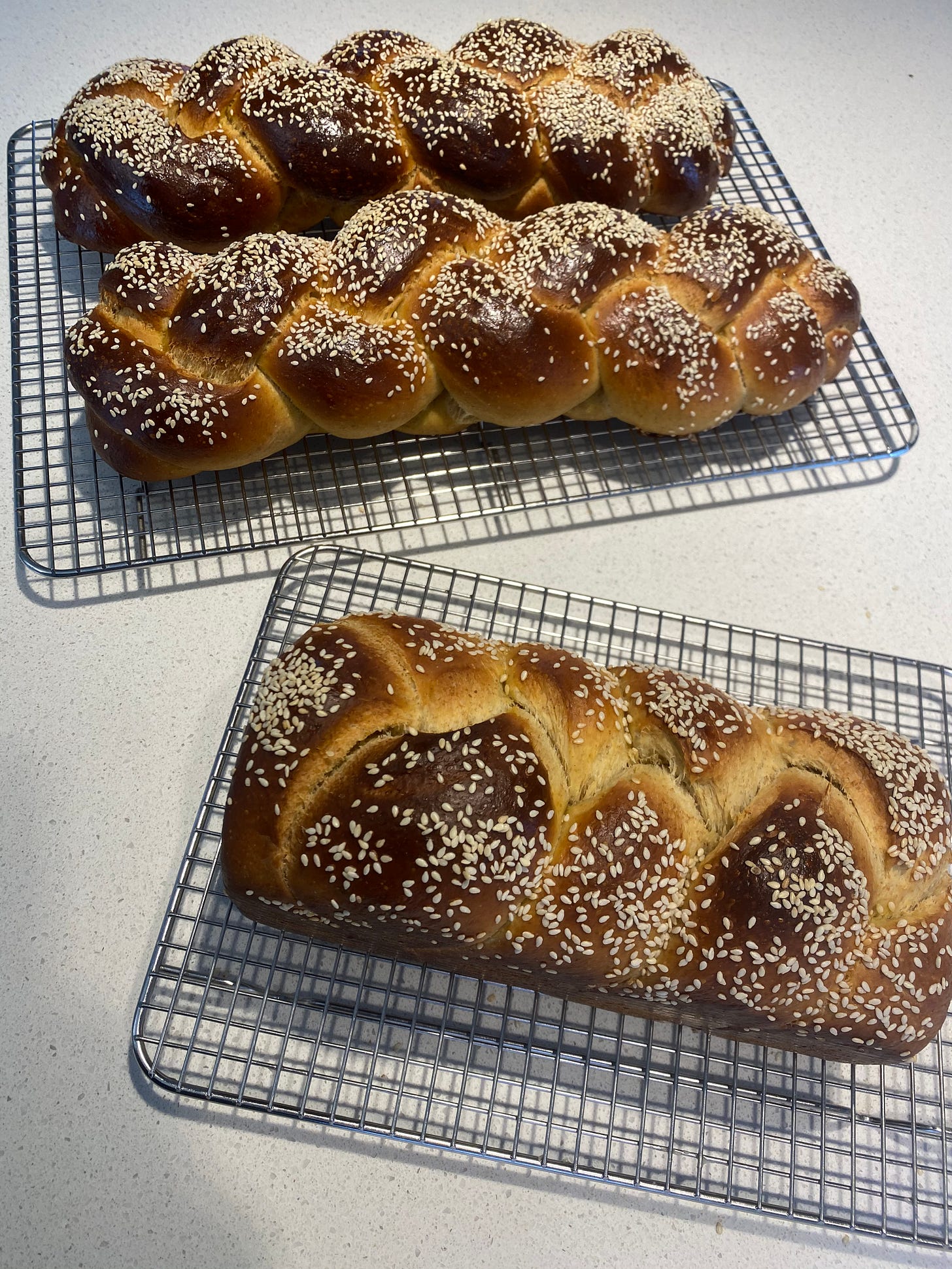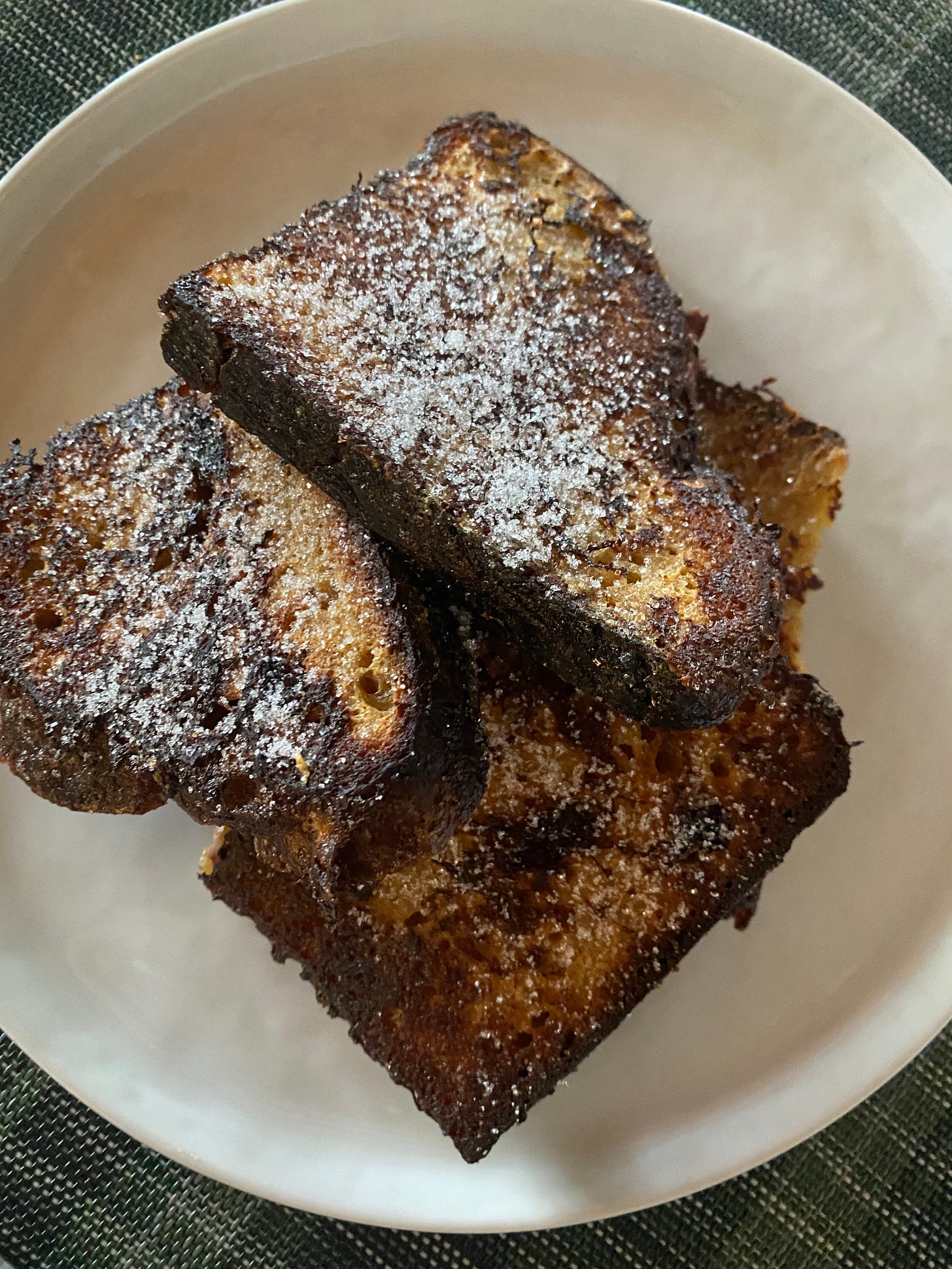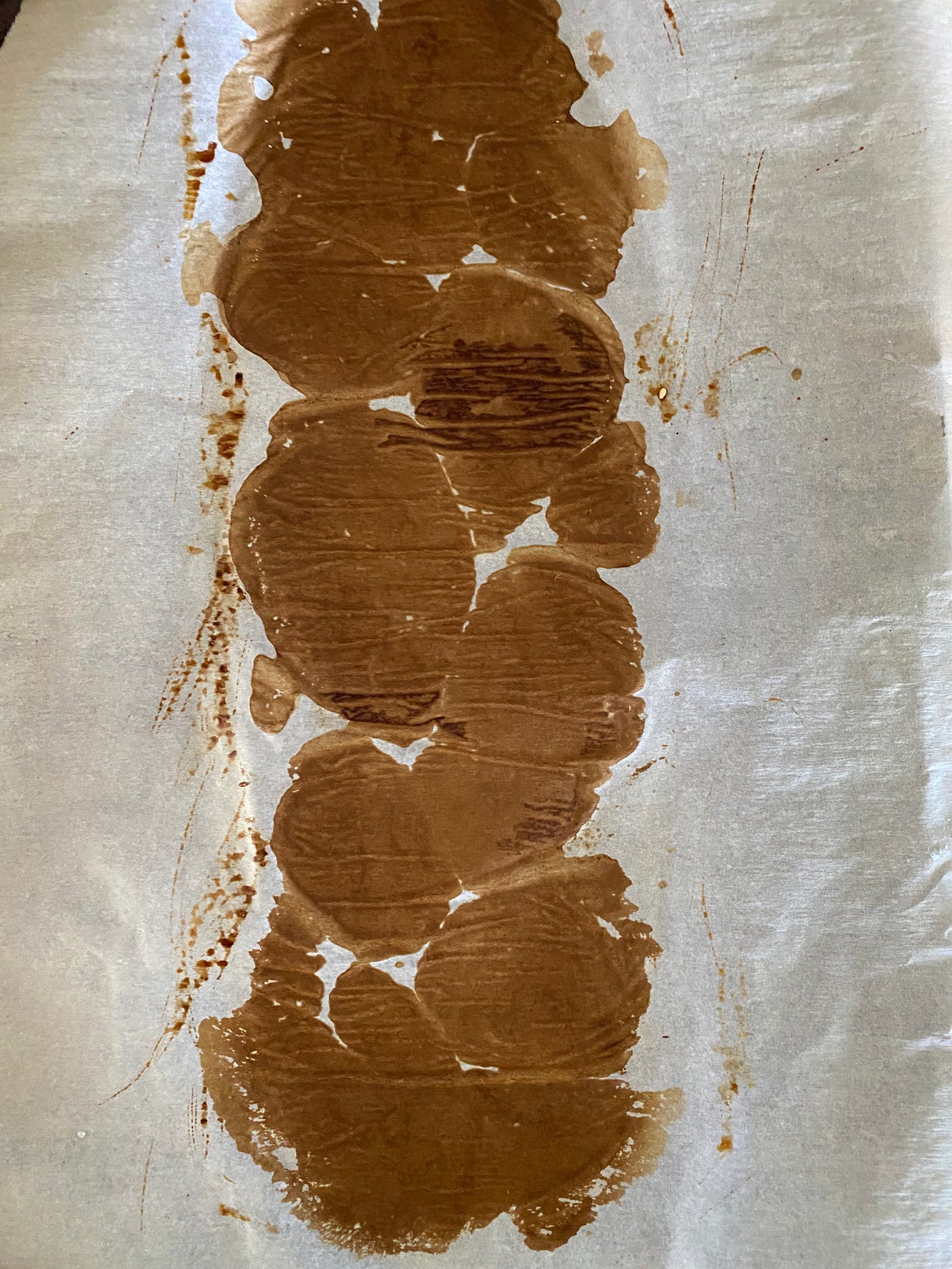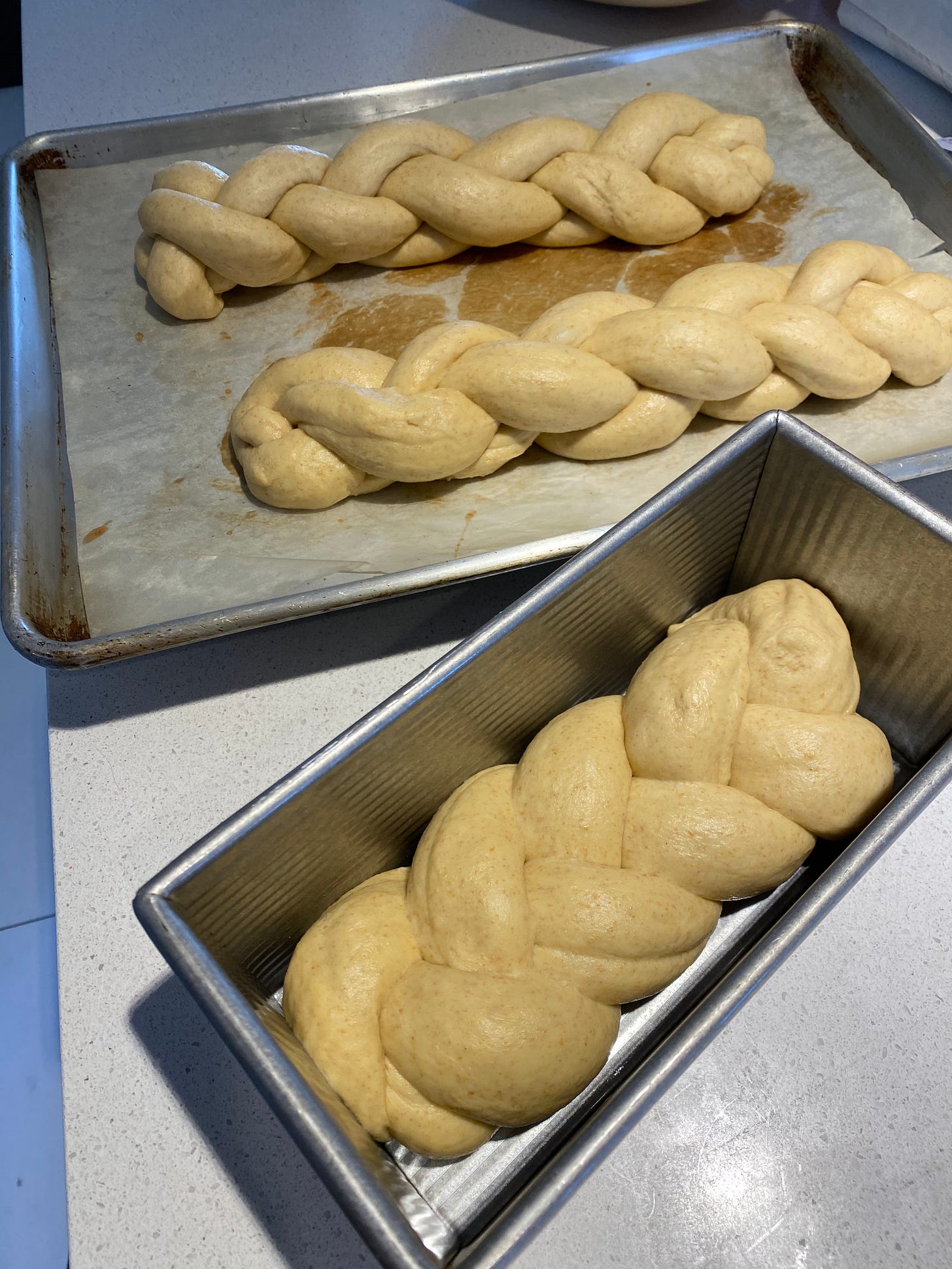Does Challah French Toast Count as Fusion Cuisine? And Other Important Jewish Bread Questions
Weekday French Toast, Challah Baking Resurgence & Evolution, Enter Sourdough, Braid-y Bunch, Challahgrams, and More
Issue #21 has arrived, just in time for Friday Night Dinner and Sunday Brunch. Hope you enjoy it. Thank you for signing up and sharing this this post and Kitchen Sense with others. And if you have paid to subscribe, double thank you for your support. It’s very gratifying to be growing this community of cooks. —Mitchell
One of the great things about making challah every week for Shabbat or Friday night dinner or just ‘cuz you have a routine is having challah around to eat throughout the week. We don’t usually observe Shabbat in any religious way, but I do often make challah on Fridays. It is my husband’s favorite bread.
Challah is the traditional Jewish festive bread, enriched with egg, oil, and sugar, and usually braided. (On Rosh Hoshana, the Jewish New Year that was observed last month, challahs are shaped round for symbolic reasons.) I grew up in a very Jewish neighborhood of Toronto—I should have spelled it neighbourhood, nu?—where the bakeries all sold rectangular loaves of challah throughout the week and braided ones on Fridays. Challah was the sandwich bread of my youth: peanut butter and jelly on challah, grilled cheese on challah, egg or tuna salad on challah, ham and cheese on challah. When the challah went stale, we used it for French toast.
I was surprised to learn as an adult living in New York City that challah here still holds somewhat of a special place, available in many Jewish bakeries on Fridays and holidays, but not all week long. What’s more, who knew that challah French toast was considered something “fancy.” In the 1990s, we waited forever to get a table at the Royal Canadian Pancake House in the still-then-gentrifying neighborhood of Tribeca, where in addition to their absurdly oversized pancakes they also served French toast made from an entire loaf of challah split lengthwise in half. Better brunch places still proudly tout “Challah French Toast” on their menus. Even our friend and pandemic podmate, Laurent Gras, a renowned French chef who basically has brioche coursing through his veins, likes to use challah for French toast. (And no, French toast is not the same thing as pain perdue.)
RECIPE: Challah French Toast
It’s best to use stale challah sliced about an inch thick. If your challah is too fresh it will not absorb the egg mixture. If I make a challah on Friday, I slice some of it thick and leave it unwrapped to go stale for French toast Sunday morning. Once stale, you can also freeze the slices for weekday French toast. They just take a few minutes to defrost before you soak them. Many people suggest that you make the egg mixture in advance and soak the bread in it overnight, which produces a rich, custardy French toast, for sure. But to be honest, because challah French toast is a regular weekday breakfast in our house, I just soak it before I fry it. I like that the bread retains some of its breadiness. If you want a more custardy version, you can double the egg mixture and soak the bread in a single layer in a covered baking dish overnight in the fridge. Better yet, make friend Bonnie’s delicious, bread-pudding-like Challah French Toast Casserole, which we served at a brunch with did together at the James Beard House back in 2007.
(Makes 4 servings)
2 large eggs
2/3 cup whole milk
1/3 cup half and half, or additional whole milk
2 teaspoons pure vanilla extract
¼ teaspoon ground cinnamon
About 4 tablespoons unsalted butter
Eight ¾” to 1” slices stale challah
2 tablespoons sugar
Preheat the oven to 350°F.
In a wide, shallow bowl, beat the eggs with the milk and half and half until well blended and frothy. Beat in the vanilla and cinnamon. (Don’t worry that the cinnamon will sort of float on top.) Depending on how large your slices of challah are, you might want to transfer this mixture into an 8”-square baking dish so you can dip the bread more easily.
In a large, heavy frying pan, heat a tablespoon or so of the butter over medium-high heat. As the butter melts, dip a piece or two of the challah into the egg mixture. Hold the bread down for a few seconds so it absorbs the liquid, then flip it over and let it sit. If the bread is dense I will poke holes in it with a fork to increase absorption. When the butter begins to sizzle audibly, lift the soaked bread out of the egg mixture with a large fork or slotted spatula, drain it a few seconds, and transfer it to the hot pan. Repeat with another piece or two of bread so that the pan is full, but the bread is not touching.
Fry the French toast until crisp around the edges and dark golden brown, 6 to 8 minutes. Peek underneath to make sure it is cooking evenly. If the center of the pan is browning faster than the edges, rotate the slices in the pan. When evenly browned, flip and cook for 3 or 4 minutes more to brown the second side. Dust the browned side of the French toast, now facing up, with some of the sugar in an even layer. Take the pan off the heat. Transfer the French toast to a baking sheet, arranging it in a single layer, and continue dipping and frying the rest of the challah, adding more butter to the pan off the heat to melt each time before you add the next batch. If it looks like you are going to run out of the egg mixuture, you can thin what you’ve got with some more milk or cream and keep working until it is all gone. Arrange the final pieces of the French toast on the baking sheet and set in the preheated oven for 7 or 8 minutes to cook through and melt some of the sugar on top. Serve hot.
Challah Resurgence: The Braid-y Bunch
I think a resurgence in challah making has been sparked by Instagram, where a new generation of bakers post tantalizing photos and videos of their handiwork. I’m in awe of the Challah Prince’s elaborate braids. Jake Cohen’s lovely loaves deserve special mensch-tion. And I so look forward to seeing my friend Bonnie Stern’s weekly challah posts because she is always trying new “twists” with her heavenly dough—garlic knots, cinnamon buns, and all kinds of different shapes among them.
As we are in the midst of a new season of the Great British Baking Show, I hope you will allow me a digression. If you’re an avid fan, as I am, you might recall the curious “8-Strand Plaited Loaf” that was the technical challenge in U.S. Season 1, Episode 2 (which was actually U.K. Season 5, Episode 2, as the seasons are numbered differently across the pond). Although it sounded like challah and looked like challah and judges Paul Hollywood and Mary Berry even referred to it as a “traditional festive bread,” no one acknowledged that it was, in fact, a Jewish challah that they were making. While researching exact details of the episode, I stumbled on many funny threads about this strange omission, which is where I learned that in Hollywood’s 2012 How to Bake cookbook he included a recipe for “Chollah Loaf,” a “classic Jewish bread” from his friend Sylvia Woolf, made with milk and butter, that she serves on Passover (!). Sure, Paul.
My Challah Evolves: Bread Flour and Sourdough
For decades I’ve been making challah using the same recipe that I first published in The Mensch Chef in 2002 and that you can find included along with some of my Rosh Hashanah recipes in the archives of the Jewish Food Society. (Note that the recipe archived there includes raisins and instructs you to make the bread round, both traditional for the Jewish new year. But you can easily omit the raisins and braid the dough as described below.)
Last May, shortly into the pandemic shutdown I participated in an online workshop that Jewish Food Society did from Erez Komarovsky and Adeena Sussman, live from Erez’s home in the Galilee. A famous baker and chef, Erez demonstrated how to make gorgeous stuffed challahs, the strands of which he filled with vegetables and cheese and then braided with herbs. I During that workshop, Erez said in Israel he uses “challah flour,” but that he recommended bread flour everywhere else. So, I have been using bread flour for my challah ever since. I also tried my hand at one of his stuffed challahs. Fun.

Since I began my personal sourdough journey about a year ago, I’ve started baking a slightly different challah each week, one that incorporates some of the sourdough starter I have to discard to feed my main starter. This recipe still uses regular commercial yeast, but it incorporates the starter discard as a substitute for some of the flour and water in my regular recipe. My starter is fed with 100% whole wheat flour (and sometimes whole rye) so its adds both flavor and whole grain to the dough.
Not sure exactly why, but the addition of discard and perhaps the high-gluten bread flour necessitates more time for the dough to rise, about 4 our 5 hours for each proof. So, I like to make this challah over two days, preparing the dough and allowing the first proof to take place on Thursday, then refrigerating the dough overnight and shaping it Friday morning. This long, cool fermentation also contributes to the flavor. It takes a good three or four hours to rise after shaping, so by about noon it is ready to bake. Finally, I use extra-virgin olive oil in this and in all my baking, which I think adds a pleasant savoriness, though you can use any neutral oil, as well.
RECIPE: Mitchell’s Sourdough Challah
263 g (1 cup) sourdough discard, 100% hydration, preferably whole grain
100 g (1/2 cup) warm water
2 large eggs, plus an additional egg for the wash
60 g (1/4 cup) sugar
50 g (1/4 cup) extra-virgin olive oil
7 g (2 teaspoons) instant yeast
540 g (3 1/2 to 4 cups) bread flour
22 g (1 tablespoon) kosher salt, plus a pinch for the egg wash
Place the sourdough discard, warm water, eggs, sugar, olive oil, yeast, and 500 g of the bread flour into the bowl of stand mixer fitted with a dough hook. Add the salt and mix the dough on low speed until it comes together into a sticky mass. Scrape down the bowl, increase the speed to medium-low, and knead for about 7 minutes until the dough is soft and elastic and less sticky. You may have to scrape the dough off the hook once or twice. Wet your hand to pull it off the hook. Remove the dough from the bowl onto a clean, lightly floured surface and knead for a couple of minutes, adding as much of the remaining 40 g of flour as you need to keep the dough from sticking to your hands. Shape into a ball.
Transfer the dough to an oiled bowl, invert to coat the entire surface with oil, then cover the bowl with plastic wrap and a dish towel, and let rise at room temperature until more than double in bulk, about 5 hours and as long as 8 hours. Punch down the dough and refrigerate overnight. Braid or otherwise shape while the dough is still cold.
To Shape
I usually make a 4-strand braid. And I do it in a way I swear I read about somewhere years ago but that I haven’t been able to find since. I’m not saying this is the best way, just that it’s the one I remember. There are plenty of videos on Youtube showing you how to braid four-strand challahs. Here’s my technique.
Punch down the chilled dough. Transfer to a clean, not-floured work surface. Divide the dough into four equal pieces. You want to lightly flour a long area of your counter away from where you are working or a half-sheet pan so that you can place the strands of dough there to rest without sticking. But note it’s much easier to roll the strands out on a clean, unfloured surface.
Take the first piece of dough and pat it with the heal of your palm into a small, longish rectangle. Fold it in half lengthwise onto itself and pat it down again into a rectangle. Fold it in half lengthwise again. This folding is to to help build up the surface tension of the dough to it holds its shape. Using the flat of your fingers of both your hands and a gentle touch, now roll the rectangle into a long, even rope, about 18 inches long and 1 inch in diameter, tapered on both ends like a torpedo. Lift to rest on the surface you floured and repeat with the remaining three pieces of dough.
To braid, lay out the four strands alongside eachother perpendicular to you. Weave together the tapered ends farthest away from you. Take the outer-most strand on the right and cross it over the two strands to its left. Now bring it back under the strand now at its right. Do the same with the farthest-left strand, bringing it over two strands to the right, and back under one to the left. I repeat the mantra aloud, “over two, under one,” to help me remember what to do. But I realize this sort of instruction is really hard to read and figure out, so watch the videos and find one that makes sense to you. I won’t be insulted.
Transfer the challah to a parchment-lined sheet pan, cover with a dish towel, and let rise at room temperature 3 to 5 hours until double in size and puffy. Preheat the oven to 425°F.
Beat the extra egg with a tablespoon or so of water and a pinch of salt. Brush the risen challah with this egg wash. Let egg wash dry for about 10 minutes and then brush again (this gives a dark, shiny finish). Sprinkle with seeds (sesame or poppy or both) and/or flaked salt. (Everything Bagel mix is good, too.) Bake 20 minutes then lower the oven to 375°F. and continue baking until evenly dark brown and the center reaches an internal temperature of 205°F., about 15 minutes more. Remove from the oven, transfer to a rack, and allow to cool completely before serving.
When You Don’t Want to Make Your Own Challah and/or You Want to Send Someone a Challahgram Gift
For years Nate and I have gathered with friends in Maine to celebrate Thanksgiving. One year, while out on a hike the Friday after the feast, we came home to find a large box left by FedEx on the doorstep. Inside was a stunning six-pound, three-foot Challahgram, which one of our friends sent the group. I’d never seen such a big challah, and even more impressive, it was totally delicious. We ate the challah that night for dinner, but we had plenty leftover for sandwiches and French toast throughout the weekend. Available in a few sizes and guaranteed to arrive from Brooklyn on Thursday or Friday anywhere in the U.S., I highly recommend these challahs. They make great gifts and great French toast.












